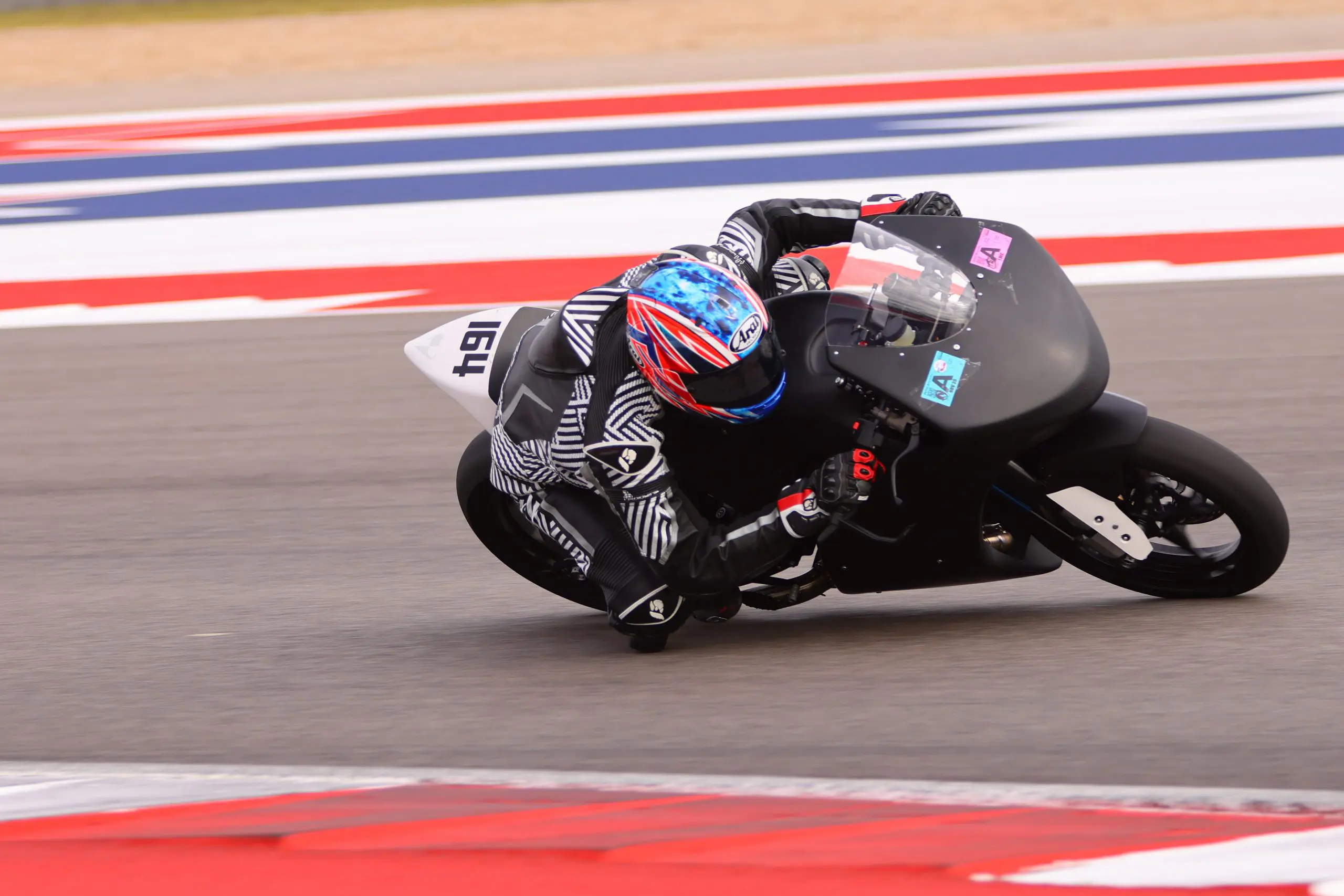
Kyle Ohnsorg, an accomplished MotoAmerica racer, engineer, and owner of Adrenaline Engineering—which specializes in motorcycle suspension and chassis tuning—has been instrumental in testing and preparing the Krämer APX-350 MA for its debut in the brand-new MotoAmerica Talent Cup Championship this March.

After testing the bike in October at Talladega Gran Prix Raceway, located near Munford, Alabama, Ohnsorg and crew traveled to Texas last month to test the bike again, this time at Circuit of The Americas (COTA) in Austin, the world-class road course where America’s best and brightest young riders will be aboard the Krämer and on the world stage during the Red Bull Grand Prix of the Americas MotoGP round on March 28 through 30.
Here is Ohnsorg’s full testing report, in his own words:
We had another round of testing in late November, and this time, it was a two-day test at COTA where we focused on revisions to the triple clamps, suspension linkage, and the valving for both the front and rear suspension. Our main goals were to improve the feel and handling of the bike and prove that it worked well at a bigger track where the Talent Cup riders would be racing this coming season.
Dunlop Senior Race Tire Technician Tony Romo was with us to help test tire compounds, which played a key role in learning what window the tires operated best in for the Krämer. Tige Daane, MotoAmerica’s Technical Director, was also there to oversee the testing and development, and also to ensure that the bike was in line with the needs of the racers and teams that are expected to compete in MotoAmerica’s brand-new spec series.
At the start, we ran into some issues with chatter, especially from the rear of the bike. But, after some careful analysis, we realized it was a combination of the cooler track temperatures and tire pressures that were too high for those conditions. Because the APX-350 MA is a lightweight bike, it is harder to build up heat in the tires, which led to inconsistent performance throughout the earlier sessions. But, as the ambient temperature climbed above 60 degrees, we were able to build heat in the super-sticky Dunlop tires, allowing us to do faster laps and fine-tune the setup. The grip from the tires was fantastic, and it didn’t show any significant fall-off in performance throughout the day. We also opted for the softer swingarm and triple clamps to further help with edge-grip feel.
One of Krämer’s goals in creating the APX-350 MA was for it be a versatile bike that can easily be tuned for different riding styles and tracks. So, besides changing hard parts to better suit COTA’s surface, we also raised the ride height using insert “chips” for ground clearance, adjusted the seat position eccentrics for increased rider comfort on the long straights, and shortened the wheelbase to put a bit more weight on the rear tire. We found a range that worked well for both stability at higher speeds and nimbleness in tight corners that I am confident will suit most riders’ preferences.

I rode in the advanced group at COTA, which meant the Krämer 350cc single and I were on track with the 1000cc bikes. Surprisingly, I was able to maintain a similar or faster pace than most of the riders there, which I was extremely impressed with. The straightaway-to-corner “yo-yo” effect was so apparent that they began letting me go out first with a 15-second lead since only a few of the riders were able to run my pace. The literbikes obviously held an advantage in top-end but the Krämer’s blazing-fast corner speed and razor-sharp handling helped level the playing field. I kept thinking to myself, “The Talent Cup racers are going to have so much fun drafting and battling on these little missiles.”

After COTA, I joined the test team at Dunlop’s facility in Alabama where we continued testing tires in various conditions. Taylor Knapp, Dunlop’s primary test rider, was also there to provide feedback, and he rode the bike, too. Overall, Taylor’s initial feedback was tremendously positive, and we only needed to make minor tweaks to the bike to get it dialed in for his riding style. A small adjustment to the preload and a few clicks on the suspension made a noticeable difference in his comfort and confidence. Once those minor changes were made, Taylor was able to push the bike, and he had nothing but positive things to say about it.
After the sessions at COTA and Dunlop, the Krämer team traveled to Jennings GP in but Florida to continue refining the bike’s setup with former GP and World Superbike Champion John Kocinski throwing a leg over the bike and doing some fast laps. Krämer’s testing process has been incredibly thorough, and the team is putting in a serious amount of work to ensure that the APX-350 MA will be ready for the upcoming season.
As Krämer continues to move forward, I have no doubt that the APX-350 MA will be a top performer and a new favorite bike among many racers. With the work we’ve done and the feedback we’ve gathered, the bike is ready to race, in my opinion. I am really looking forward to seeing how it performs during the upcoming season. As someone who has worked with bikes at the highest level of racing for more than 10 years, I can tell you that Krämer Motorcycles is truly putting in the time, effort, and resources to make sure the APX-350 MA is the best bike it can be for the Talent Cup riders and teams.
Ohnsorg would like to thank Hart Photography for the on-track images, Bison for the “prototype-look” suit they provided, Arai for the helmets, and Krämer USA for the opportunity to ride and test the APX-350 MA. Special thanks also to Ohnsorg’s wife Lindsey and his employees at Adrenaline Engineering for holding down the fort while he was off testing.








